Save-A-Lot
 | |
| Subsidiary | |
| Industry | Retail |
| Founded | 1977 |
| Headquarters | Earth City, Missouri |
Number of locations | 1,280 |
Key people |
Eric Claus (CEO), Tom Lenkevich (COO) |
| Products | Bakery, dairy, deli, frozen foods, general grocery, meat, produce, snacks, seafood, liquor |
| Parent | SuperValu |
| Website |
save-a-lot |

Save-A-Lot is an American hard discount supermarket chain headquartered in Earth City, Missouri, near St. Louis, Missouri, United States.[1] The subsidiary of SuperValu comprises more than 5,900 stores across 36 states in the United States with over $4 billion in annual sales.
While stores carry most typical grocery products, they feature less variety than conventional supermarkets. A typical Save-A-Lot is 15,000 square feet (1,400 m2) with items displayed in their cardboard shipping boxes.
History
Save-A-Lot was founded in 1977 by Bill Moran as an alternative to larger supermarkets. He opened the first Save-A-Lot store in Cahokia, Illinois, and remained with the company until his retirement in 2006. Moran oversaw the expansion of his company from the one Cahokia store to more than 1,000 locations across the country. He was succeeded as President and CEO by Bill Shaner, previously COO of Save-A-Lot. Shaner began his career at Save-A-Lot in 1999 after spending 15 years in the operations division at parent company Supervalu. In May 2011, Bill Shaner was replaced as President and CEO of Save-a-Lot by Walmart veteran Santiago Roces, who most recently served as senior vice president and general manager of Walmart's small format division.[2][3]
In September 2012, Supervalu announced it would close 22 Save-A-Lot stores in seven states.[4][5] Several executive changes were made by Supervalu on March 4, 2013, including replacing Save-A-Lot CEO Roces with Ritchie Casteel. This came in the midst of plans by Supervalu to sell a number of its other grocery chains to Cerberus Capital Management.[6]
In October 2016, SuperValu announced they are selling Save-A-Lot to Onex Corporation.[7]
Expansion
In 1978, General Grocer Company expanded the company's presence in the greater St. Louis area. Eventually, the store network grew to 30 stores by the end of the decade. At the root of company's growth strategy is its licensee relationship, in which Save-A-Lot acts as a wholesaler to its independent store owners as opposed to a franchisor. Smaller, independent grocery retailers soon found the limited assortment model to be an effective defensive strategy against the larger chain supermarkets. With help from new licensees, in 1980 alone Save-A-Lot added 50 stores in the Mid-South region, and a warehouse in Jackson, Tennessee.
Acquisitions
In 1987, Save-A-Lot was purchased by St. Louis-based food retailer and wholesaler Wetterau Inc, then owner of current sister stores Shop 'n Save.
The next year became the company's biggest in terms of store growth. In 1984, Save-A-Lot purchased 75 similar format Jewel T stores and two distribution centers from Jewel in Florida and Pennsylvania.
In 1994, both the Save-A-Lot and Shop 'n Save banners became wholly owned subsidiaries of Supervalu Inc, one of the largest independent grocery wholesalers, and the owners of Cub Foods and Scott's Food & Pharmacy at the time. The acquisition opened up Save-A-Lot's licensee opportunities to conventional Supervalu-supplied operators, including Niemann Foods.
Save-A-Lot expanded into southern California with the purchase of 21 discount-grocery Sav U Foods stores, and a distribution center from the Fleming Companies in late 1996.
Deal$
In 2002, Save-A-Lot acquired discount variety store chain Deal$: Nothing Over a Dollar with 45 stores in the Midwest. The typical Deal$ store had a slightly smaller footprint than Save-A-Lot and carried mostly non-food merchandise at dollar-increment price points. The Deal$ concept was expanded under Save-A-Lot to 138 stores by 2006.
The acquisition also allowed Save-A-Lot to stock more general merchandise in its grocery stores. The company experimented with hypermarkets which combined the discount grocery and merchandise concepts under one roof. This eventually led to 480 combination stores that did not carry the Deal$ banner.
Four years later, Save-A-Lot sold Deal$ to variety store rival Dollar Tree for $30.5 million plus inventory.[8] Save-A-Lot has reduced the amount of general merchandise in its combination stores and returned them to its grocery-focused model.
Recent expansion

In late 2009, newly hired Supervalu CEO Craig Herkert announced the goal to double the Save-A-Lot store network (to 2,400 locations) within five years.[9] The company would open nearly 100 stores in 2010 with a major focus on the Southeastern United States. Save-A-Lot plans to open a new distribution center in Davidson County, North Carolina, in 2011 that will service a portion of the new and existing stores.
Save-A-Lot also entered into a licensing affiliation with notable Hispanic grocer Rafael Ortega to rebrand six former Save-A-Lots in Houston, Texas, and South Texas as "El Ahorro Save-A-Lot".[10] The new stores feature Save-A-Lot product offerings along with more traditional Hispanic staples.
In late 2010, drug store chain Rite Aid became a licensed Save-A-Lot operator when it converted 10 of its existing pharmacies in the Greenville, South Carolina area to co-branded "Save-A-Lot/Rite Aid" units.[11] The stores have preserved the pharmacy, but replaced the bulk of its health and beauty general merchandise with Save-A-Lot grocery products including fresh meat, produce, and frozen items.
Business model
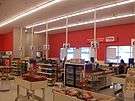
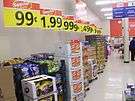
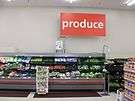
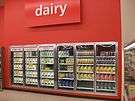
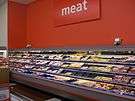
Store layout
The typical Save-A-Lot store footprint ranges between 15,000 square feet (1,400 m2) to 16,000 square feet (1,500 m2). However, it is not uncommon to see a store that is under 10,000 square feet (930 m2) or over 16,000 square feet (1,500 m2). The smaller footprint enables Save-A-Lot to convert existing structures into grocery stores and serve various communities and locations. The company is able to reduce labor and shelving costs by ordering, shipping, and displaying its products in custom cartons. This also means its stores do not offer services such as salad bars, sushi bars, delis, cafeterias, baristas, or floral departments. Therefore, customers do not pay for these services in the end price of the product. The stores usually have four to six checkout lines. Save-A-Lot had previously included money transfer and check cashing services at some of its locations, but discontinued these money centers in 2009.
Most Save-A-Lots have their fresh produce section near the front entrance of the store. In some cases, a "Special Buys" section is at the front of the store. This aisle includes products stacked on pallets rather than shelves that have been temporarily reduced in price (due to Save-A-Lot's bulk purchasing). Fresh meat, deli and smoked meats, and dairy are typically found at the back of the store. Frozen foods are generally positioned on the perimeter opposite the produce section. The inner aisles are reserved for grocery, general merchandise, and pet products.
Limited assortment concept
Save-A-Lot employs a limited assortment concept in its production selection, which results in an advertised 40% price advantage over conventional supermarkets. The stores generally offer strictly private label product and in only one size. This has resulted in a reduction of SKUs from 30,000 at conventional supermarkets to roughly 1,250. Save-A-Lot does offer national brands from time to time, including Coca-Cola, Little Debbie, Banquet Foods, Chef Boyardee, Pringles, Oscar Mayer, and others.
The company leverages its store network of over 1,300 in negotiating prices with its suppliers. Save-A-Lot contends many of these suppliers are the same manufacturers of leading national brands. In essence, Save-A-Lot shoppers do not pay for the marketing and advertising costs associated with nationally branded products. Save-A-Lot puts its name on these products, as Walmart has done with their Great Value private-label products, and also offers a 100% money back guarantee.
Save-A-Lot exclusive brands:
- Kaskey's — soups
- Coburn Farms — dairy
- Bubba — sodas
- Ginger Evans — baking products
- Fairgrounds — deli meats
- J. Higgs — salty snacks
- Señora Verde — tortillas and tortilla chips
- Kurtz — condiments
- Malone's — canned meats and beans
- Mantia's — pasta and Italian
- Nature Trails — wholesome snacks
- Port Side — seafood
- Portman's — salad dressing
- Skillet Masters — meal mixes
- Save Today — various products
- World's Fair — frozen desserts
- Wylwood — canned vegetables
In addition to larger supermarkets, Save-A-Lot primarily competes with other chains with similar business models, most notably Aldi, but also PriceRite, and C-Town Supermarkets, as well as Dollar General Market, the supermarket format of Dollar General. Like many of these stores, Save-A-Lot cuts costs by charging for bags (some stores do not charge); however, it does encourage shoppers to use their own bags from home as well as boxes from the back stock that are left for customers to use as an alternative for bags. Some Save-A-Lots do, however, bag groceries for customers with their own bags at no extra cost, depending on the franchisee.
Licensed owners
A majority of Save-A-Lot stores are owned and operated by independent licensees. Save-A-Lot supplies much of these stores with its exclusive branded products, but the licensed owners have the freedom to sell other non-Save-A-Lot products at their stores. Some licensees have added services beyond the traditional Save-A-Lot model that includes bakeries, delis, liquor, tobacco, money transfers, and fuel services.
The distribution of licensed stores is spread across the contiguous United States. Most of these stores are located in small rural communities in Kentucky, Tennessee, Michigan, Indiana, Ohio, Western Pennsylvania, and Western New York.
After announcing it would double the size of the company in 2009, Save-A-Lot began offering a licensee incentive program to spur growth in its licensed division. Pending financial approvals of each individual applicant, Save-A-Lot offered to provide a minimum of $200,000 in capital assistance per new store. The program began in late 2009 and is in effect through early 2011.[12]
In 2010, Save-A-Lot expanded its presence into the Caribbean with licensed stores in San Nicolas, Aruba and Roseau, Dominica. In 2013, it opened a branch in Champs Fleurs, Trinidad on the Eastern Main Road.
Major licensees include Houchens Industries of Bowling Green, Kentucky; Alliance Foods of Coldwater, Michigan; Saver Group of Campbellsville, Kentucky; and Lofino Food Stores in Beavercreek, Ohio.
References
- ↑ News & Media Save-A-Lot. Retrieved on August 19, 2009.
- ↑ "Wal-Mart Vet Roces Named CEO of Save-A-Lot as Shaner Departs". Supremarket News. May 12, 2011. Retrieved September 10, 2012.
- ↑ "Supervalu taps Wal-Mart exec to head Save-A-Lot". St. Louis Post-Dispatch. May 13, 2011. Retrieved September 10, 2012.
- ↑ "Supervalu announces additional store closures". Drug Store News. September 5, 2012. Retrieved September 10, 2012.
- ↑ "Supervalu closing 22 Save-A-Lot stores". St. Louis Post-Dispatch. September 6, 2012. Retrieved September 10, 2012.
- ↑ Solomont, E.B. (4 March 2013). "Supervalu shakes up leadership of Save-A-Lot, Shop 'N Save". St. Louis Business Journal. Retrieved 5 March 2013.
- ↑ "Supervalu to Sell Save-A-Lot Chain to Onex for $1.37 Billion". Bloomberg. Retrieved October 17, 2016.
- ↑ "User account | Supermarket News". Subscribers.supermarketnews.com. Retrieved 2012-10-22.
- ↑ Fresh & Easy Buzz (2010-04-20). "Fresh & Easy Buzz: CEO: Supervalu to Open 100 New Sav-A-Lot Stores This Year; Strategy to Double Store-Count to 2,400 in 5 Years in Place". Freshneasybuzz.blogspot.com. Retrieved 2012-10-22.
- ↑ "Save-A-Lot Unveils Partnership for Hispanic Stores | Latest News content from". Supermarket News. 2010-07-21. Retrieved 2012-10-22.
- ↑ Elliot Zwiebach (2010-09-13). "Save-A-Lot, Rite Aid to Test Co-Branded Stores | Retail & Financial content from". Supermarket News. Retrieved 2012-10-22.
- ↑ http://save-a-lot.com/sites/save-a-lot.com/own/Save-A-Lot_Licensee_Incentive_Program.pdf